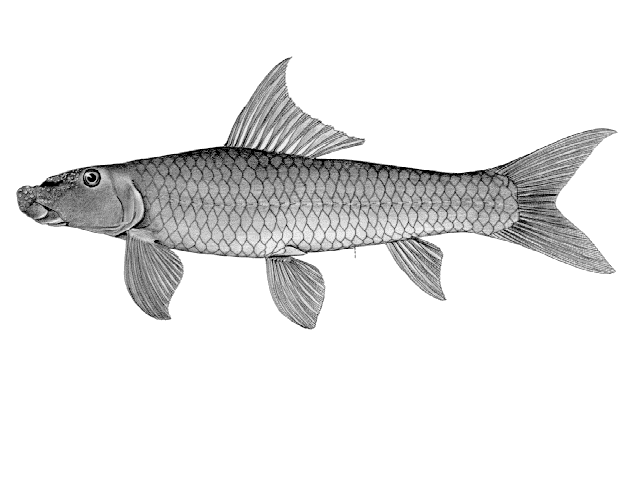| Cyprinidae (Minnows or carps), subfamily: Labeoninae |
| 17.5 cm SL (male/unsexed) |
|
benthopelagic; freshwater |
| Africa: principal coastal rivers of southern Cameroon to Cabinda, and from the Congo River basin (Ref. 26192). Also reported from the Cunene (Ref. 11970) in Angola. |
|
Dorsal spines (total): 0-0; Dorsal soft rays (total): 9-10; Vertebrae: 31-33. Diagnosis: snout rounded and prominent, usually with deep transverse furrow and very well-developed fleshy appendage at its anterior end (Ref. 26190, 81639). Scale formula: 38-39 (38 commonly observed); 4.5-5.5 (5.5 commonly observed); 3.0-3.5 (3.0 commonly observed); 14-16 (16 commonly observed); dorsal fin with 9-10 (10 commonly observed) branched rays (Ref. 81639). Upper edge of dorsal fin always concave (Ref. 26190, 81639). 31-33 (33 commonly observed) vertebrae; ventral fin origin located under the 4th branched dorsal ray; genital opening distal from anal fin origin; dark brown longitudinal band on flanks, not flared over scaled base of caudal fin (Ref. 81639).
Description: eye relatively small and supero-laterally positioned (Ref. 26190, 81639. Longest dorsal fin ray 20.2-36.1% SL; caudal peduncle narrow, depth 11.6-17.3% SL (Ref. 81639).
Coloration: in preservation, brown or dark brown above lateral line, beige or light brown ventrally; dark longitudinal band always present but less clearly defined in large individuals (Ref. 81639). |
| Maximum TL recorded: 48.5 cm (Ref. 2801). Occurs in flowing rivers; consumed as food (Ref. 11970). |
|
Least Concern (LC); Date assessed: 16 February 2009 Ref. (130435)
|
| harmless |
Source and more info: www.fishbase.org. For personal, classroom, and other internal use only. Not for publication.
